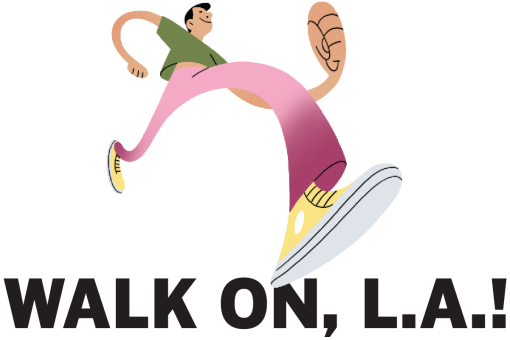Walking is considered one of the healthiest ways to exercise, but let’s be honest: Unless you have a dog dragging you to the door or a friend pulling your arm, it’s easy to find reasons to stay on the couch. Especially in a place like L.A., where cars typically take us from point A to point B.
These 10 walking clubs won’t help you get a dog, but they can give you a compelling reason to get up and out. They’re as much about exercise as they are about socializing and exploring.
Here in L.A. there are groups for almost every interest and skill level, and almost all the clubs are free. Some, like the SoCal Stair Climbers, average a brisk 2.5 miles an hour as they explore L.A.’s myriad stair walks. Others, like the Slow Walkers Club, let the slowest participant set the pace, and sometimes help them finish a route. Achilles International Los Angeles provides guides to help people with disabilities get moving, while L.A. Leggers is focused on training walkers and runners for the L.A. Marathon.
All the groups share a similar, overarching goal: to help people make connections while moving.
“It’s easier to get out when you’re in a setting of like-minded individuals,” said Laura Murillo, founder of SoCal LGBTQ+ Explorers. “Our little catchphrase is: ‘Making friends as an adult is hard, exploring SoCal is easy!’”
Achilles International Los Angeles| Culver City EverWalk Walking Club | Hot Girl Walk | Long Beach Walking Club| Los Angeles Hiking Group | L.A. Girls Who Walk | L.A. Leggers | Slow Walkers Club | SoCal LGBTQ+ Explorers | SoCal Stair Climbers

Achilles International Los Angeles
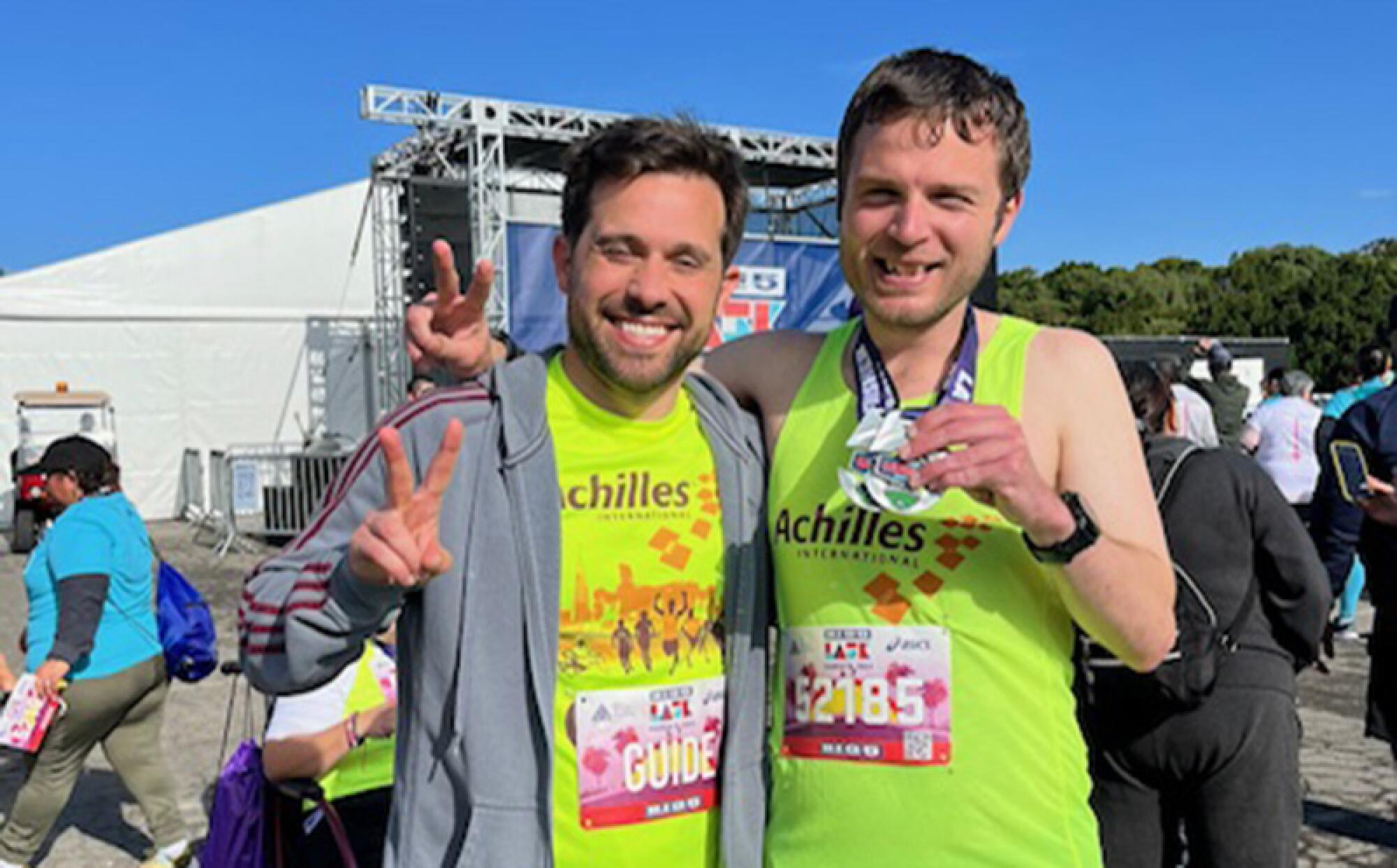
Achilles International was established in 1983 “to transform the lives of people with disabilities through athletic programs and social connection,” according to its website. Today it has programs in 18 countries, including the United States. Its Los Angeles chapter creates opportunities for people with physical and mental disabilities to participate in running, walking and other athletic events with the help of nondisabled volunteers, or “guides.”
Achilles International Los Angeles
Athletes range from “people with autism and no physical disabilities to people who are blind or amputees — we have a lot of veterans who lost their legs,” said Christina Swanson, who was inspired to run the L.A. Marathon after watching a blind woman guided by volunteers complete the race in 2019. Swanson became a volunteer guide herself that year and in 2020 became the Los Angeles chapter’s president.
The L.A. chapter hosts walks the first Sunday of every month at 10 a.m. at Dorothy Green Park in Santa Monica and is starting a second monthly walk in the South Bay area, with times and days to be announced.
The chapter had only a few athletes and guides when Swanson first got involved, but today about 50 people — athletes and guides — show up for walks every month, she said. (Swanson said several of her friends have signed up as guides since she got involved.)
After training and a background check, volunteer guides are paired with athletes. Typically, a walk involves warm-up stretches before people tackle the three-mile trail starting at Dorothy Green Park, although some athletes may walk longer routes. What the guides do also varies: “Some blind athletes just need someone to be their eyes and keep them from walking off the path; others might need two guides to make sure they stay safe,” Swanson said.
Guides are encouraged to converse as much as possible with their athletes and, if possible, train with them on additional days at locations that are convenient to them both. “A lot of our blind athletes can’t drive, so it’s sometimes a big lift for them to get to Santa Monica or the South Bay,” she said. “If our volunteers can meet with them someplace else, it helps them out.” — Jeanette Marantos

Culver City EverWalk Walking Club
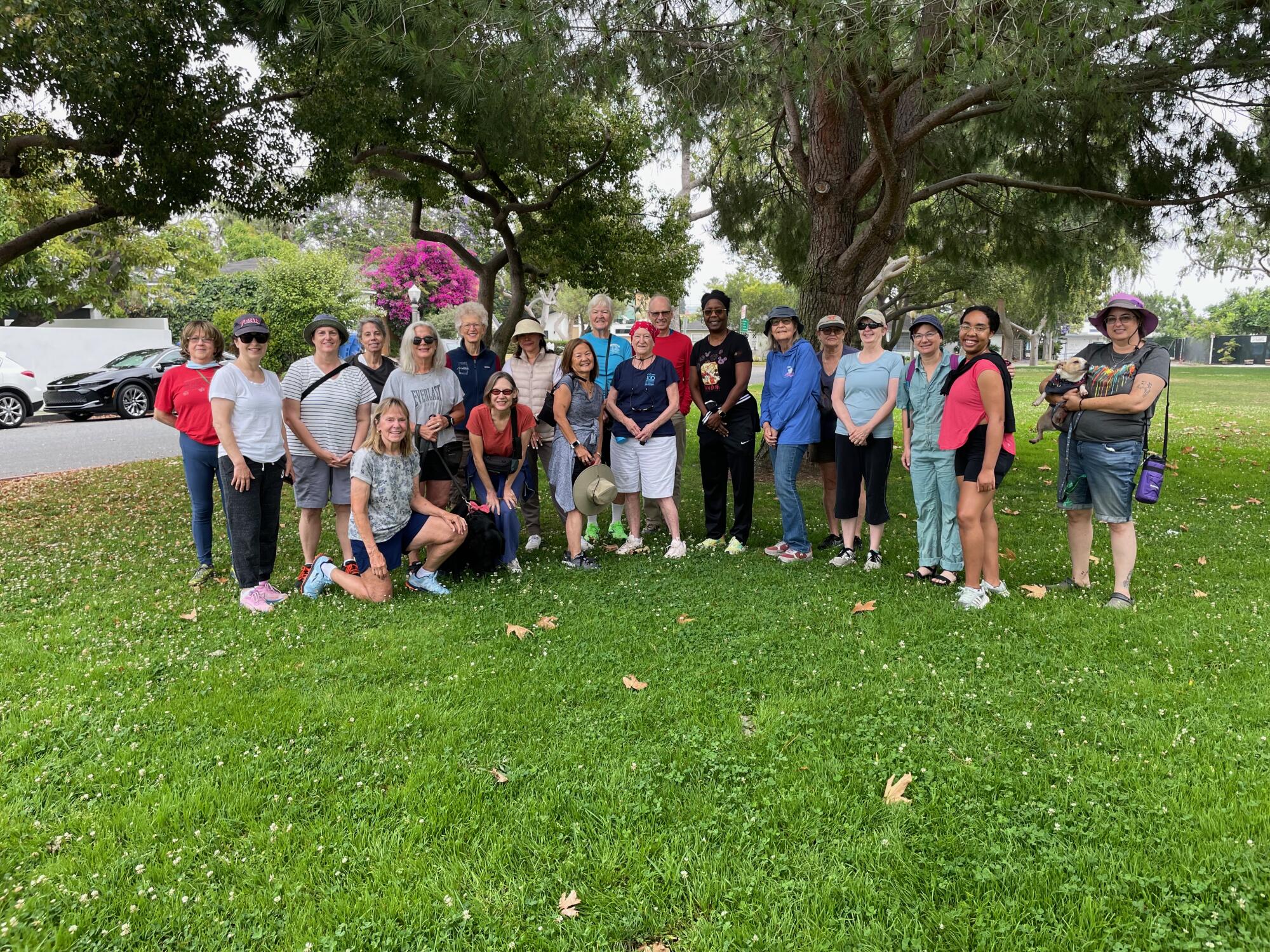
When, in 2016, long-distance swimmer Diana Nyad and her friend and coach Bonnie Stoll organized the first EverWalk event — a 135-mile trek from Santa Monica to San Diego over seven days — Culver City resident Laura Petersen “signed up and completed the walk (much to my surprise!),” she said in an email. “That’s when I seriously caught the walking bug!” And when Nyad and Stoll called on volunteers to lead walks in their communities, Petersen stepped up once again, starting the Culver City EverWalk Walking Club in 2018.
Culver City EverWalk Walking Club
Since then, except for about a year during the COVID-19 pandemic, she has led walks once a month, following different routes of about three miles. When she resumed the walks in 2021, she decided to always start at Coombs Park in Culver City, usually the first Saturday of every month from 9 to 10 a.m., “to make it something people could count on.” Her co-leader and husband, Peter, joins the walks each month to help ensure everyone is included.
“We cater to all kinds of walkers, which is sometimes tricky if we have some people walking faster or slower than others,” Petersen wrote. “Peter’s taller and faster, so he’s usually up front, whereas I usually stay with the slower walkers, kind of like a mother hen, to make sure I can see all my chicks ahead of me.”
Membership is free, and while the focus of EverWalk is to get people moving, these walks are also a great way to make new friends. “It’s so much easier to chat with people you’ve just met when you’re on the move, walking side by side,” she said. “I love when we get to the end of a walk and I hear people say, ‘The time just flew by!’” — Jeanette Marantos

Hot Girl Walk
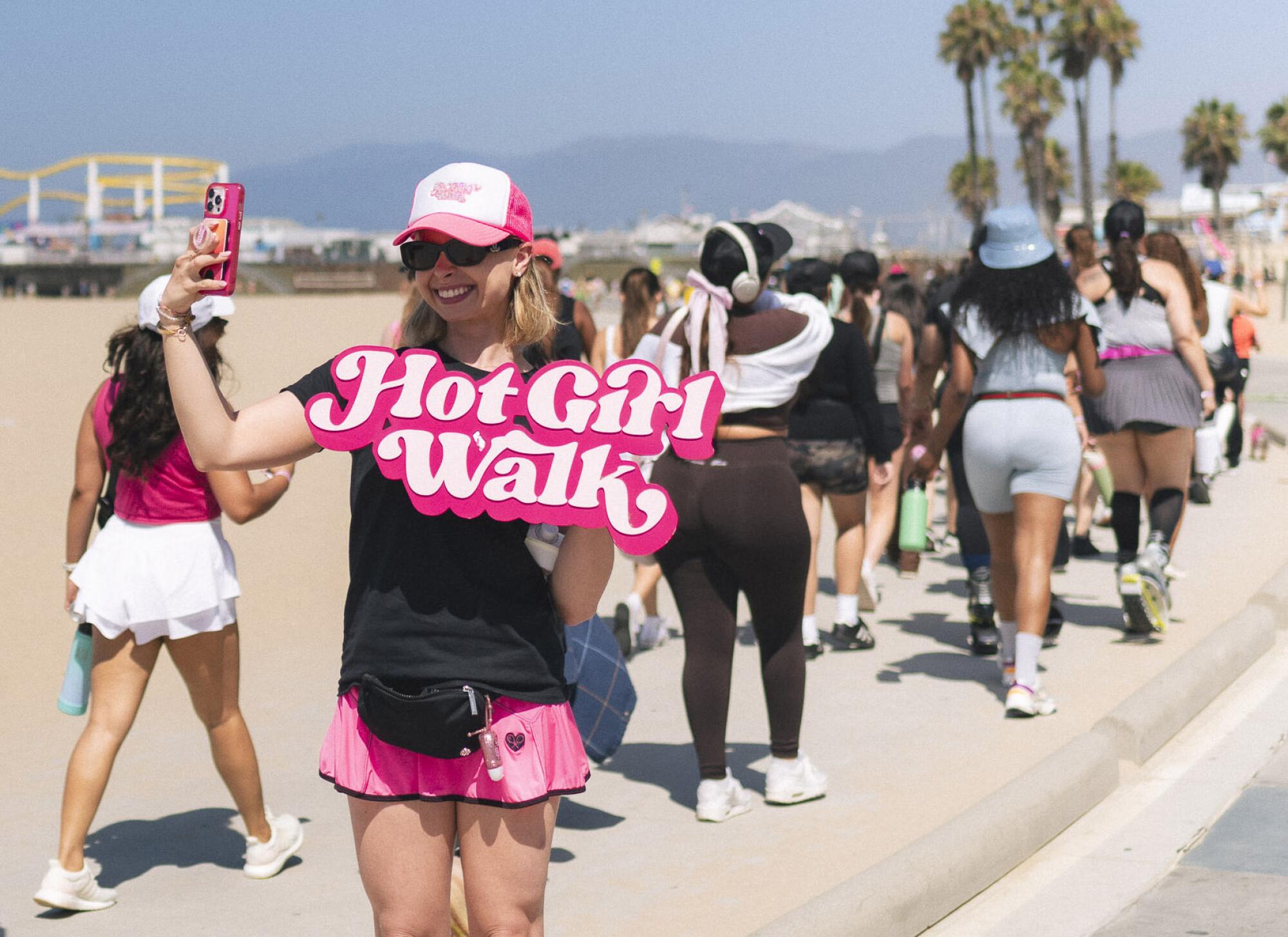
Mia Lind was a 22-year-old communications major and sorority president at USC trying to combat the stress and anxiety in her life when her motivational post about “hot girl walks” went viral on TikTok in January 2021. The idea is that women should stop obsessing about intense workouts to get skinny and instead take daily mindful walks focusing on gratitude, goals and their self-worth, because those are the things that really make you hot.
“When I walk, I think about how grateful I am for the people who love me, and how proud I am about what I’ve achieved and all my new goals. … And that’s how I get to how hot I am,” Lind, 25, said laughing. The idea resonated with her sorority sisters, who urged her to post it online. It met with enough interest (and sponsors) worldwide that Lind quit her day job in September 2023, and now travels the country and the world promoting healthy living and self-worth through walking. (Her pop-up walk in London on Oct. 19 drew 400 people.)
She’s trademarked the name Hot Girl Walk and has started groups that meet regularly in Los Angeles, New York and Miami as well as pop-up walks in other cities, such as one in Boston that drew 800 people in July. There are no membership rules or fees; anyone is welcome to join the monthly Hot Girl Walk in L.A., she said, although “Hot Girl Walkers” are predominantly female. The ultimate goal: Encourage people to start walking, have fun and stop stressing. — Jeanette Marantos

Long Beach Walking Club
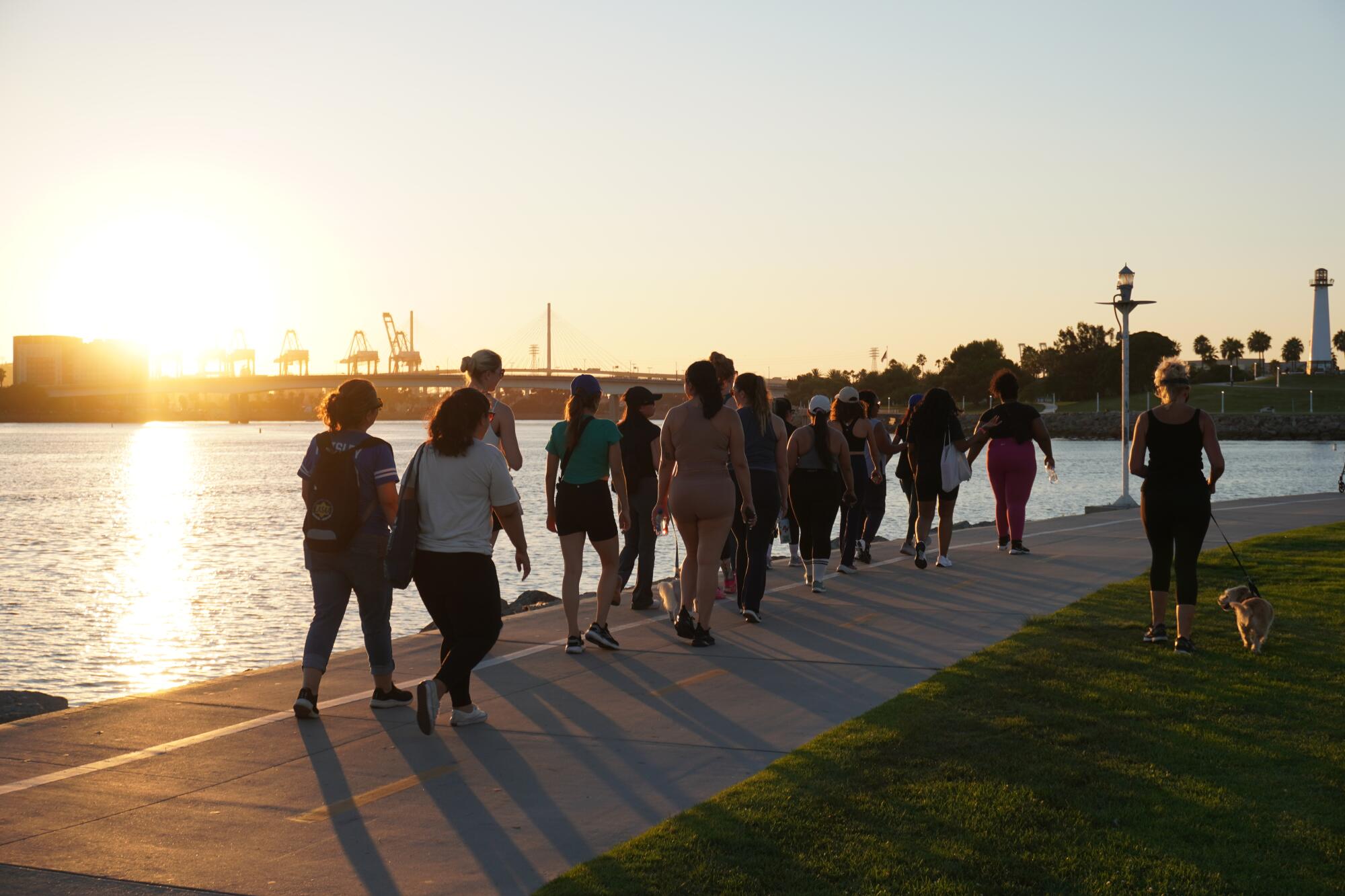
Long Beach native Evelyn Avila was looking for a safe way to meet and make friends with other women when she started the Long Beach Walking Club in April 2023. “I started my fitness journey around the same time. I didn’t know how to work out or lift weights, so I just started walking,” she said. “I saw walking clubs popping up everywhere, and I thought Long Beach would be amazing because it’s such a diverse environment.” The idea struck a chord: The group now has 18,000 followers on Instagram and 2,000 “engaged” followers who regularly sign up for events.
Avila, a 31-year-old social media manager, lived downtown at the time, so having walking buddies provided some safety in numbers too, she said. “I love walking to the beach and the shoreline, but it’s not the safest option to walk alone.”
The club offers easy walks at least once a week, along with other activities, such as recent classes about mental health and self-defense. There are also social gatherings at local restaurants or parks and community service opportunities such as food drives and toy drives. Club walks last about an hour and are designed to be easy, Avila said, adding: “These are leisurely, flat, paved walks that are more about socializing.”
Membership is free, and members are encouraged to network and set up extra walks with others in the club. Avila did all the work herself for the first nine months but now has nine “ambassadors” who help with organizing, and the club is currently applying for nonprofit status. Avila is excited about all the ways the group is building community just 18 months after it began. “This is my passion, my hobby,” she said. “Our members are glad to have this space just for women, because [spaces exclusively for women] really don’t exist. This club really helps me help them.” — Jeanette Marantos

Los Angeles Hiking Group
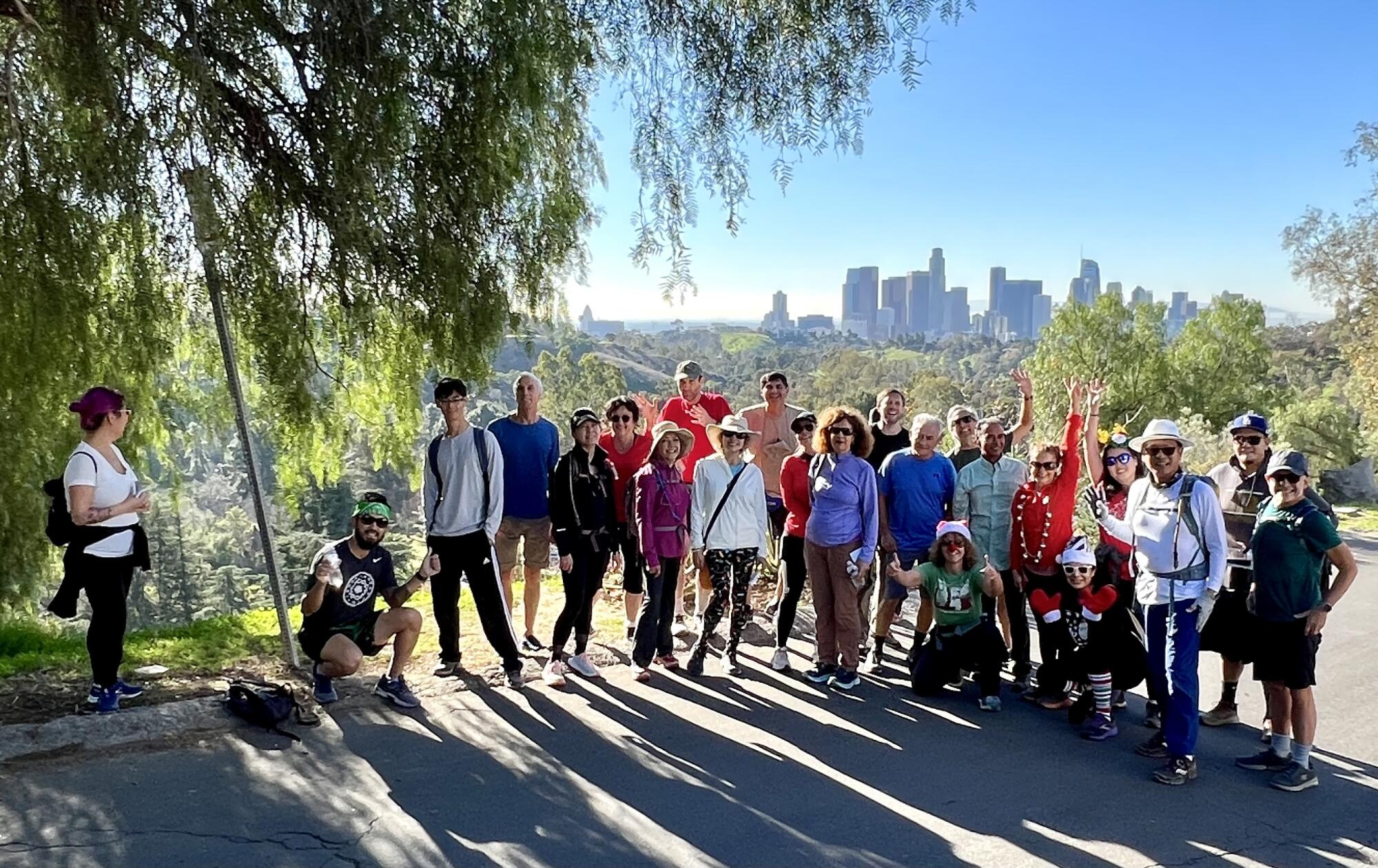
Back in 2007, friends Barry Craine and Lee Zebold started an L.A.-based group with a simple winning formula: Encourage Angelenos to have fun outdoors with others. Some 17 years later, the free, nonprofit Los Angeles Hiking Group has more than 43,000 members on Meetup and multiple opportunities every month for people to join free urban walks or group hikes organized by one of the group’s nearly 70 leaders.
“If you don’t want to travel far, an urban walk is an ideal activity for someone living in a city,” said Mike Cheng, who joined the group in 2011 and is now its president. “I’ve had the best times of my life hiking or walking. And of course it’s a great way to meet people. If you like to walk, and you meet a person who clearly enjoys what you’re doing, you have something in common right away compared to meeting someone in a bar.”
Cheng leads hikes for small groups in places such as Bishop Lake, but he also gets involved in the many urban walks. This time of year, he said, there are several nighttime excursions to admire holiday decorations. Walk leaders do a lot of research to find the best locations, he said, and it doesn’t cost anything to get involved, beyond taking the time to join. And while the membership is huge, individual walks are typically much smaller, no more than 35 people, Cheng said, out of consideration for the neighborhoods where they’re walking. “If you’re hiking in the wilderness, you can accommodate more people, but can you imagine a group of 60 people walking through a neighborhood? Anything over 35 is just too much.” — Jeanette Marantos

L.A. Girls Who Walk
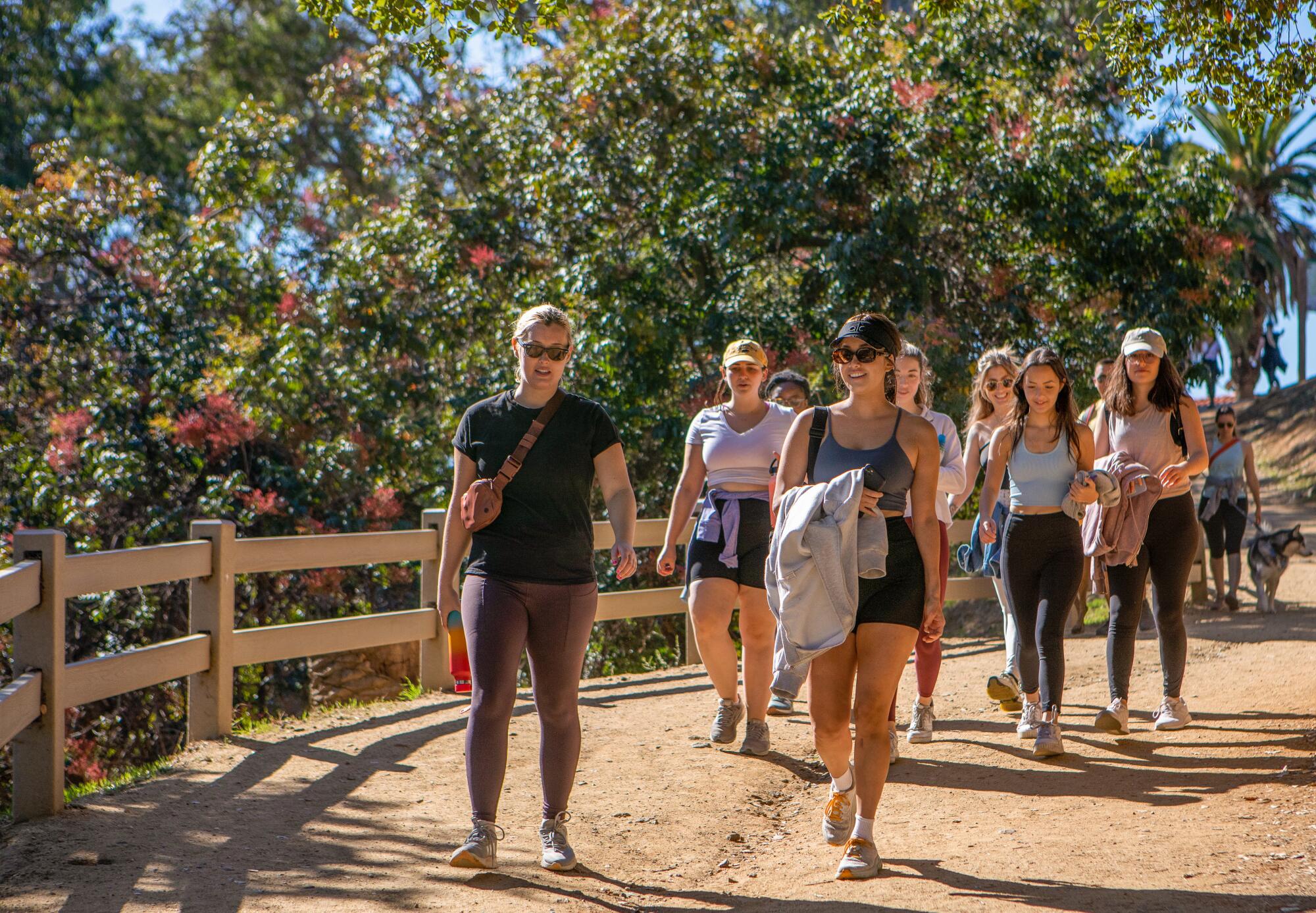
(Francine Orr / Los Angeles Times)
When Monica Figueroa was sent to work in New York City for a few months, she struggled to make friends in the bustling city. After getting flaked on multiple times by people she met on Bumble BFF (an app for people seeking friendships), the San Diego native invited a woman she connected with on the app to attend a walking event with her hosted by City Girls Who Walk. Figueroa and the woman attended several walks together and bonded with two other women, whom they added to their friend group.
But when Figueroa received a promotion that moved her to Los Angeles, she was back at square one making new mates, so she decided to start her own walking clubs. She launched L.A. Girls Who Walk in June 2023, along with another chapter in her hometown, San Diego, where she has volunteers leading walks and occasionally returns to host them herself.
Walking is “a very low-budget, accessible and healthy activity to do when you’re being social, and there really aren’t that many of those things to do [in L.A.],” said 30-year-old Figueroa. “Everything either costs money, [or] causes you to be up late at night, which is not good for your health. It just seems like everything comes with a price, and [walking] really is one of the few things that doesn’t.”
L.A. Girls Who Walk holds one or two walks per month, usually on the Westside at Palisades Park Rose Garden in Santa Monica. Figueroa hopes to host walks in the San Fernando Valley later this year. L.A. members also often get together for smaller neighborhood walks or for social gatherings like bar-hopping. The group even sells merch, including crewnecks and baseball caps. — Kailyn Brown

L.A. Leggers
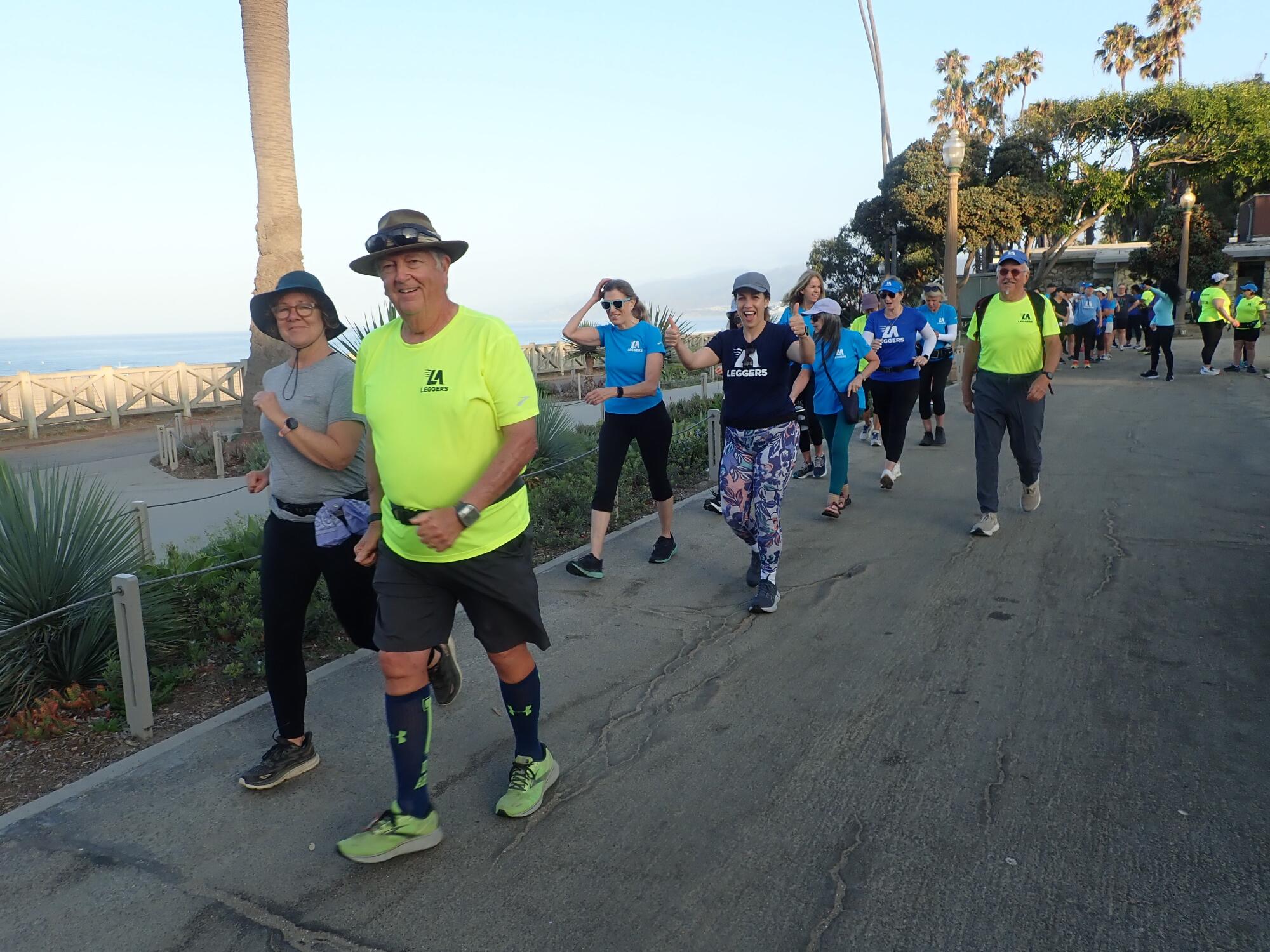
Back in December 1988, KNX radio reporter Bob Scott ran the Los Angeles Marathon equipped with a radio and microphone to conduct interviews along the way. Scott was alarmed by the number of participants he encountered on the 26.2-mile route who had no training or even awareness of what the marathon entailed, so he helped start a training club that gets people into shape for the annual marathon. Thus L.A. Leggers was born.
Today, the group has more than 600 members and an annual entry fee of $85 that helps cover the expense of T-shirts and other swag, plus discounts for running events, running equipment and, most important, social events. Members start training weekly in August until the marathon in March, and then the group takes a hiatus until the next August. (It’s too late to join the group now, but sign-ups for the next training session, which begins in August 2025, should start in April.)
The marathon includes walkers as well as runners, and about 100 of the club’s 600 members are walkers, said Vice President William Sweat. Participants are put into pace groups based on how fast they can walk or run a mile, and they increase their miles every week, going up to 20 miles per session. Members are expected to work out at least three times a week — twice with other members of their pace group and once during the weekly events; the group meets on Saturdays to work out on various routes in Santa Monica, Venice or Pacific Palisades.
Lest you worry this sounds too intense, Sweat said socializing is a key part of the training. “The mantra when you’re running or walking with the club is you should not walk until you’re winded,” he said. “You should be able to hold a conversation when you’re training, so you should be talking.” — Jeanette Marantos

Slow Walkers Club
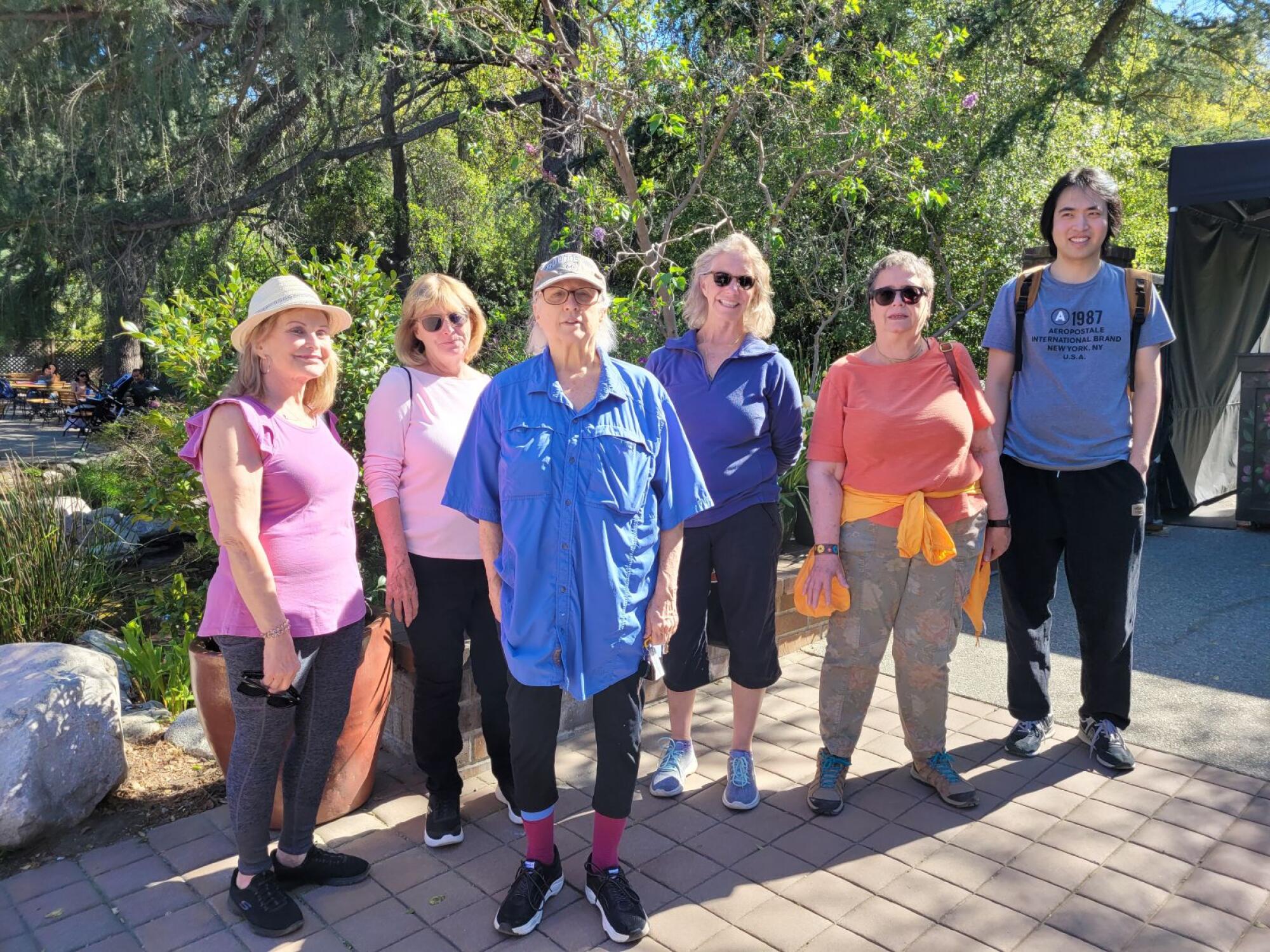
Lisa Moore likes to walk, despite “very bad knees,” but when she joined a few walking clubs, she got tired of being left in the dust. “I just couldn’t keep up with the people on those walks. People would tear out and leave me behind, so I was just walking alone.” Moore started her own group in February with a name that made her intent very clear: the Slow Walkers Club.
More than 300 people have signed up since then, but her monthly walks usually involve small groups, “and the only rule is we let the slowest person set the pace,” Moore said. “When we did the Silver Lake Reservoir walk, one woman had very bad ankle pain and there was one steep hill, so we just basically helped her get up that hill. It was hard for her, but she did it. That’s the kind of stuff I like doing, making sure everybody is included to go as far as they can go.”
Moore lives in Hollywood, but she tries to schedule walks of three miles or less all over Los Angeles, including at Descanso Gardens, the Santa Monica Pier and even the giant Ikea store in Burbank. “You can easily get 4,000 steps there,” she said. “It’s a great place to walk if it’s raining or really hot. You just follow the arrows.”
At the end of a walk, the group tries to find a place to eat and do a little more socializing. Moore said she’d like to offer more frequent walks, and hopes other members will suggest places to go. “We try to keep it fun and scenic, but the conversation and making friends is as important as the walking,” she said. “We all need to be included and not left behind. I don’t like that feeling, and I don’t think anybody else does either.” — Jeanette Marantos

SoCal LGBTQ+ Explorers
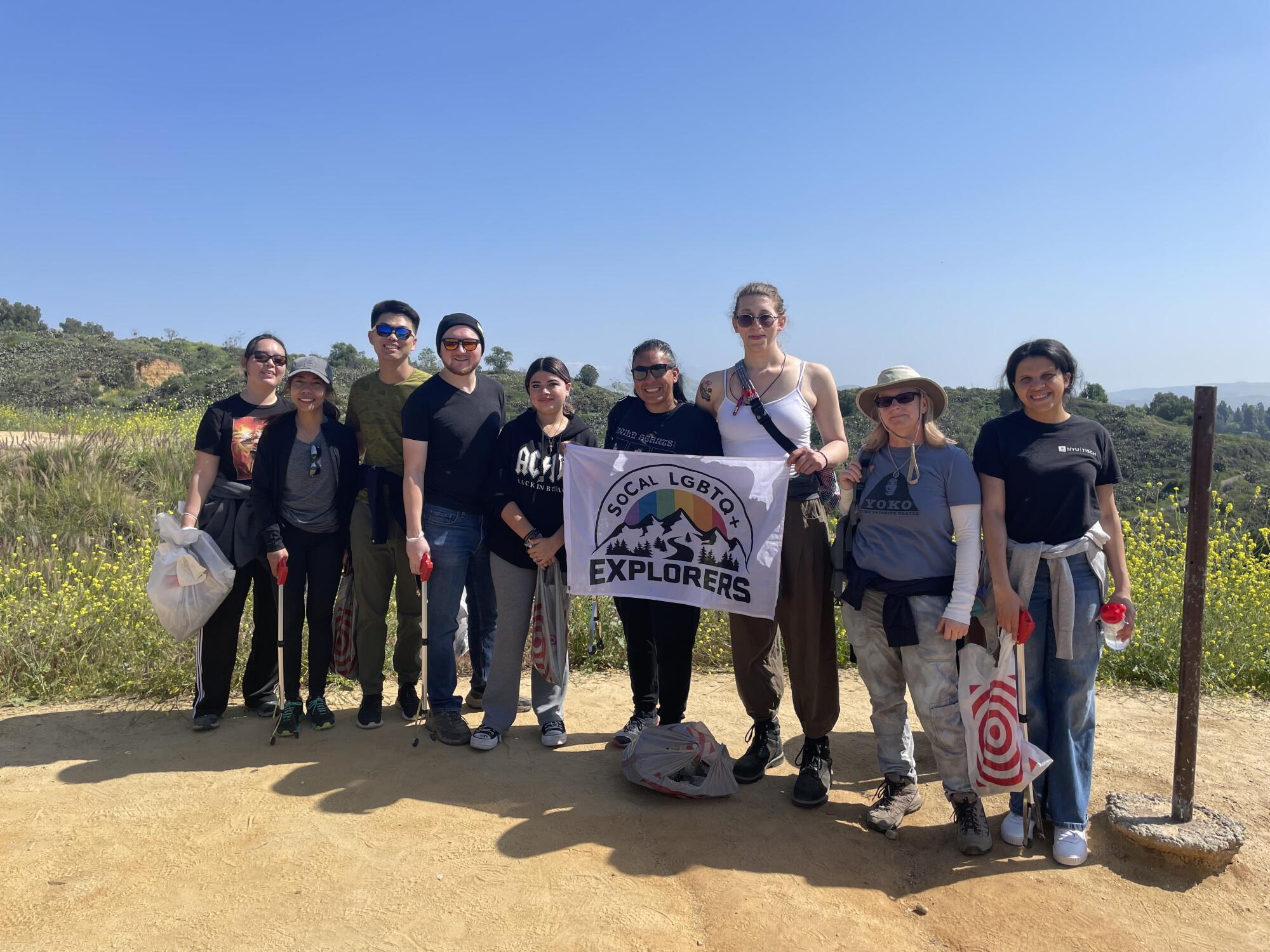
Angeleno Laura Murillo and a friend joined a walking group in Orange County in 2021, intent on doing some exploring while meeting new people. They made several new friends, she said, but every time they invited them to visit their home in East Hollywood, “We couldn’t get anyone willing to make the drive to L.A.,” she said, laughing. So in March 2022, the two decided to start a walking group closer to home, dedicated to helping others in L.A.’s LGBTQ+ community meet new people and make friends while exploring the Greater L.A. area.
The SoCal LGBTQ+ Explorers is open to everyone in the LGBTQ+ community, including allies. Most of the events center around weekly or monthly urban walks in Griffith Park and Pasadena, but there are other activities, such as walks that include picking up trash in Fullerton’s Coyote Hills, kayaking trips, museum visits and dinner or lunch after certain walks. “It’s easier to meet people when you’re in a setting of like-minded individuals,” Murillo said. “It’s not a dating thing; there’s no pressure. It’s just people getting together to go for a walk and make friends in the LGBTQ community.” — Jeanette Marantos

SoCal Stair Climbers
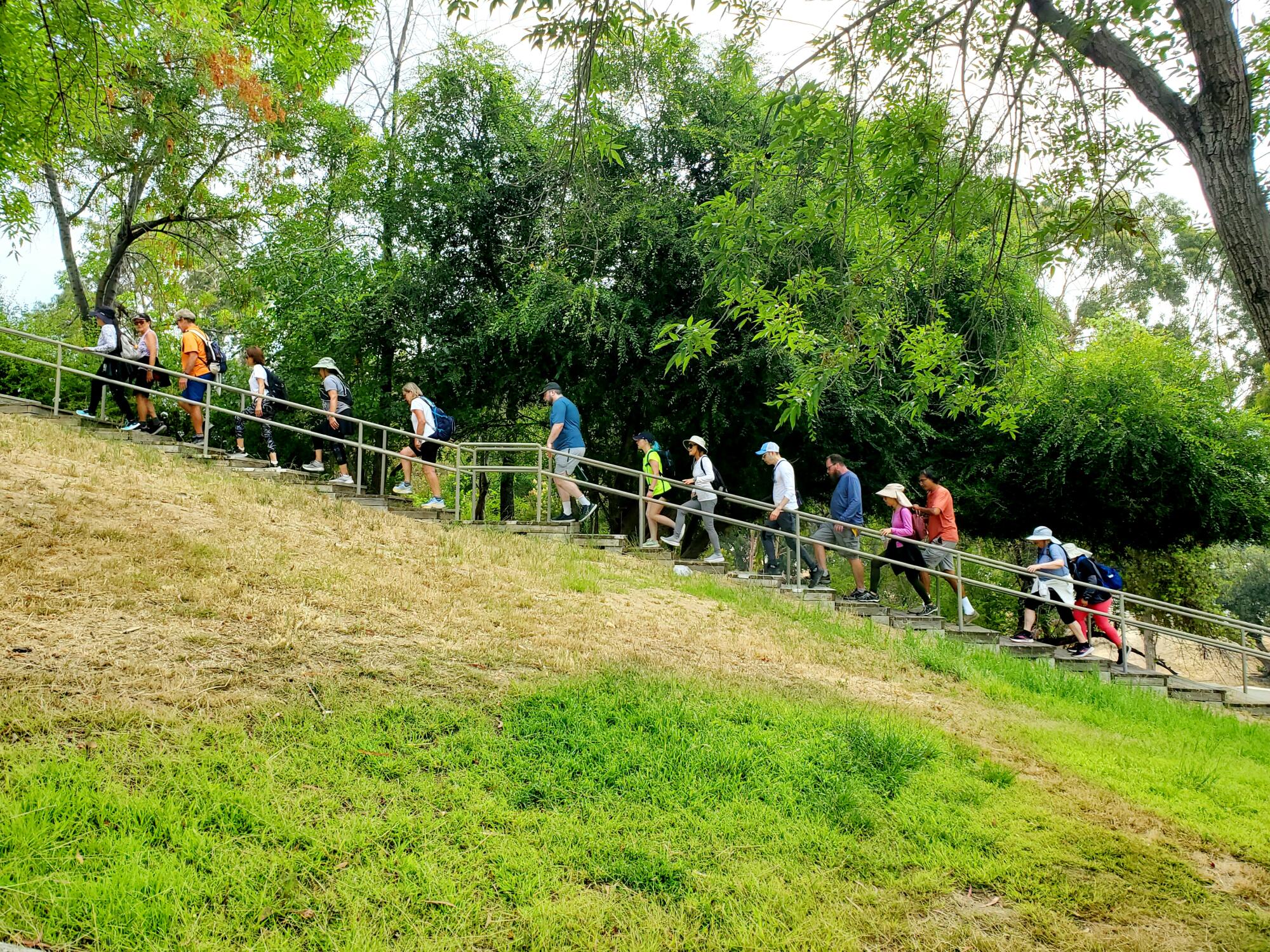
Dan Gutierrez spent years biking and mountain hiking until he found out about stair walks, a practice advocated by authors Dan Koeppel and Bob Inman. His first stair walk — on the 265-step Esther’s Steps in Silver Lake (also known as the Landa Street Stairs) — was a revelation. “I was in pretty good shape and kind of jogged up the first 92 steps, until I got to the top and realized, ‘Oh no, there’s more!’ That stairway beat the crap out of me. But I also realized that stairways are great interval training.”
Since then, Gutierrez, a satellite systems engineer, has made it his mission to catalog every stairway in the Greater Los Angeles area, including those near his home in Long Beach. He has kept a record of every walk he has done since his first excursion on Dec. 14, 2013, when the group began.
The Stair Climbers is a free group that now features multiple walks every month. One of his most popular is his Painted Stairways Tour, which involves 14 painted stairways over 6.4 miles around the Silver Lake area. The shorter excursions are after-work walks of five to six miles on Tuesdays and Thursdays led by Gutierrez in the Long Beach area, or Thursdays in Santa Monica’s Rustic Canyon, led by members Dave and Kristy Moorman.
Gutierrez also organizes longer walks of eight to 15 miles on weekends, and at least once a year offers the 305-mile, 808-stairway L.A. Loop, which he breaks up into 15 segments over many weekends. On the longer walks, Gutierrez insists that participants take an hour break midway to rest and eat a meal. “I’ve found that if you rest a bit and have something to eat, you’ll not feel as wiped out.” He designs the stops to be near places that offer several restaurant options, he said. “That’s one of the virtues of urban walks — you don’t have to carry all your food.”
Gutierrez likes to keep his walking “brisk,” averaging 2.5 miles a hour, but he also stops frequently to offer mini lessons in history and architecture, which is how he gives people a chance to catch their breath. The motto of the club, after all, is “Enjoyment, Exercise and Exploration,” so Gutierrez has found a balance. “I’ve found if you walk faster and then rest, it helps people become faster walkers, so I’m kind of training them in a gentle, hidden way.” — Jeanette Marantos
